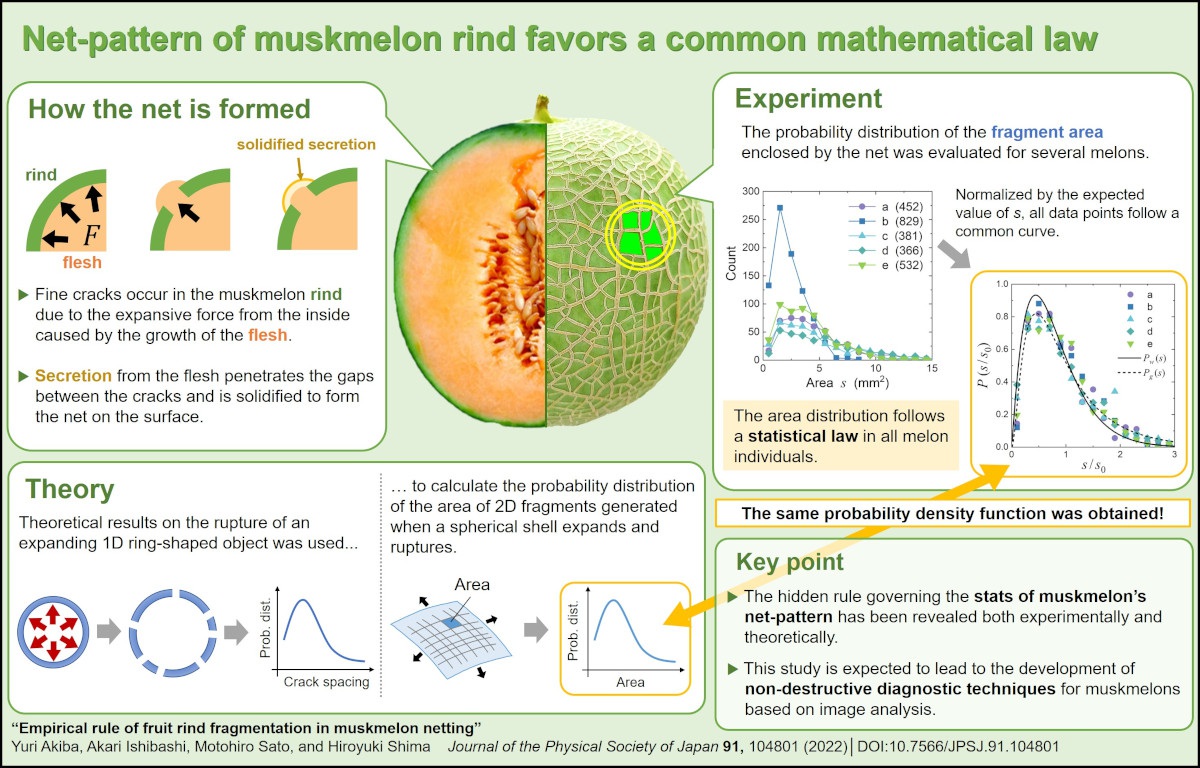Net-Pattern of Muskmelon Rind Favors a Common Mathematical Law
© The Physical Society of Japan
This article is on
Empirical Rule of Fruit Rind Fragmentation in Muskmelon Netting
J. Phys. Soc. Jpn. 91, 104801 (2022).
The surface of muskmelon is covered with a fine mesh-like net-pattern. The geometric features of the fine mesh appear unique for each individual, but hide an unexpected mathematical rule.

Professor Hiroyuki Shima’s research group at the University of Yamanashi, Japan, has discovered that the net-patterns observed on muskmelon (Cucumis melo) rinds follow a common statistical law deduced from fracture mechanics theory.
Empirically, there is a certain correlation between the net-pattern and the quality of netted melon species, like muskmelons. Yet, the geometric character of the melon’s net-pattern remains uninvestigated.
How do the melon nets form in the first place? Simply put, they are a “scab” that closes the wound on the melon’s epidermis. When the flesh of a muskmelon swells during the growth process, fine cracks appear across its surface. Subsequently, a wax-like substance (suberin, the main component of cork) is exuded from within the melon into the gaps between the cracks, filling them and then solidifying to form the muskmelon net-pattern. Similar cracking patterns are ubiquitous in nature, and are observed in dried paddy mud and aged concrete, where similar fracture processes are triggered by dehydration-induced shrinkage. This fact poses a question: are there any common scientific laws lurking in the cracking patterns of these different systems?
Shima’s research group analyzed the intricacy of the net-pattern of several commercially available muskmelons. They further derived the probability distribution curve of the area of polygonal rind fragments surrounded by a mesh, and found an almost identical distribution curve in all individual melons. Furthermore, they found that this common distribution curve is not just a coincidence, but can be described by a modified Bessel function (a special mathematical function) derived from the fracture mechanics theory of spherical shell structures. Specifically, the experimentally-derived law concerning the melon’s net-pattern has been proved to be a scientific law backed by fracture mechanics theory.
In practice, the quality of muskmelons is mainly evaluated by their appearance, with the price difference due to grade differences being much larger than that of other fruits. Currently, this sorting work is performed visually by experts, such as producers and market participants. However, relying on such expertise can lead to arbitrary subjectivity in determining muskmelon grades. If the relationship between the fruit growth process and the accompanying net formation can be clarified, it would be possible to obtain an index that enables automatic and objective determination of the ripening degree of the fruit by visual inspection. Such an index can be applied to the cultivation management of muskmelons by improving cultivation practices.
(Written by H. Shima on behalf of all the authors.)
Empirical Rule of Fruit Rind Fragmentation in Muskmelon Netting
J. Phys. Soc. Jpn. 91, 104801 (2022).
Share this topic
Fields
Related Articles
-
Solving a Stochastic Differential Equation is Solving a Mean-Field Quantum Spin System
Statistical physics and thermodynamics
Mathematical methods, classical and quantum physics, relativity, gravitation, numerical simulation, computational modeling
Magnetic properties in condensed matter
2024-5-16
The replica method maps matrix-valued geometric Brownian motion to a mean-field quantum spin system. This correspondence makes it possible to obtain an exact solution for matrix-valued geometric Brownian motion.
-
Which is Moving?—Pinning Down the Origin of Fluctuations in Muon Spin Relaxation—
Structure and mechanical and thermal properties in condensed matter
Cross-disciplinary physics and related areas of science and technology
2024-3-28
The study demonstrated that we can distinguish between the diffusion motion of the muon itself and the motion of the surrounding ions in muon spin relaxation.
-
Thermodynamic Property of a CMOS Device beyond Landauer Limit
Statistical physics and thermodynamics
Electronic transport in condensed matter
Cross-disciplinary physics and related areas of science and technology
2024-1-23
Focusing on a CMOS NAND GATE operating in a sub-threshold region, the thermodynamic cost of computation was analyzed in relation to input/output voltages surpassing the Landauer limit.
-
Possible Origin of High Thermoelectric Power Factor in Ultrathin FeSe: A Two-band Model
Electronic structure and electrical properties of surfaces and nanostructures
Structure and mechanical and thermal properties in condensed matter
Cross-disciplinary physics and related areas of science and technology
2023-12-21
The high thermoelectric power factor observed in ultrathin FeSe can be theoretically explained by a two-band model with chemical potential between upper and lower band bottoms.
-
Exploring Recent Advances in the Physics of Biofluid Locomotion
Measurement, instrumentation, and techniques
Cross-disciplinary physics and related areas of science and technology
Electromagnetism, optics, acoustics, heat transfer, and classical and fluid mechanics
Statistical physics and thermodynamics
Mathematical methods, classical and quantum physics, relativity, gravitation, numerical simulation, computational modeling
Structure and mechanical and thermal properties in condensed matter
2023-12-8
This Special Topics Edition of the JPSJ describes the latest advances in the field of biofluid locomotion, shedding light on the underlying physics behind the movement of organisms that swim and fly.
